LAW 6001 Taxation Law Case Study: Permanent Establishment and Income
VerifiedAdded on 2023/06/12
|14
|3667
|97
Case Study
AI Summary
This case study provides an analysis of several taxation law issues. It begins by examining the meaning of 'Permanent Establishment' under the UK-Australia Double Tax Agreement, explaining how business profits of a UK-incorporated enterprise are taxed in Australia, and whether contracts made through an independent agent result in a permanent establishment. It further analyzes the tax implications for Andrew McSwington, an MLB prospect playing in Australia, specifically addressing the taxability of his income and rental income from a property he purchased. The study also explores the concept of income generated from one-off sale transactions, referencing relevant case law like 'Myer v Federal Commissioner of Taxation'. Finally, it discusses allowable deductions, particularly focusing on expenses incurred at the commencement of a business, referencing cases like 'Softwood Pulp and Paper Ltd v Federal Commissioner of Taxation'. Desklib offers a wealth of resources including similar case studies and past papers for students.
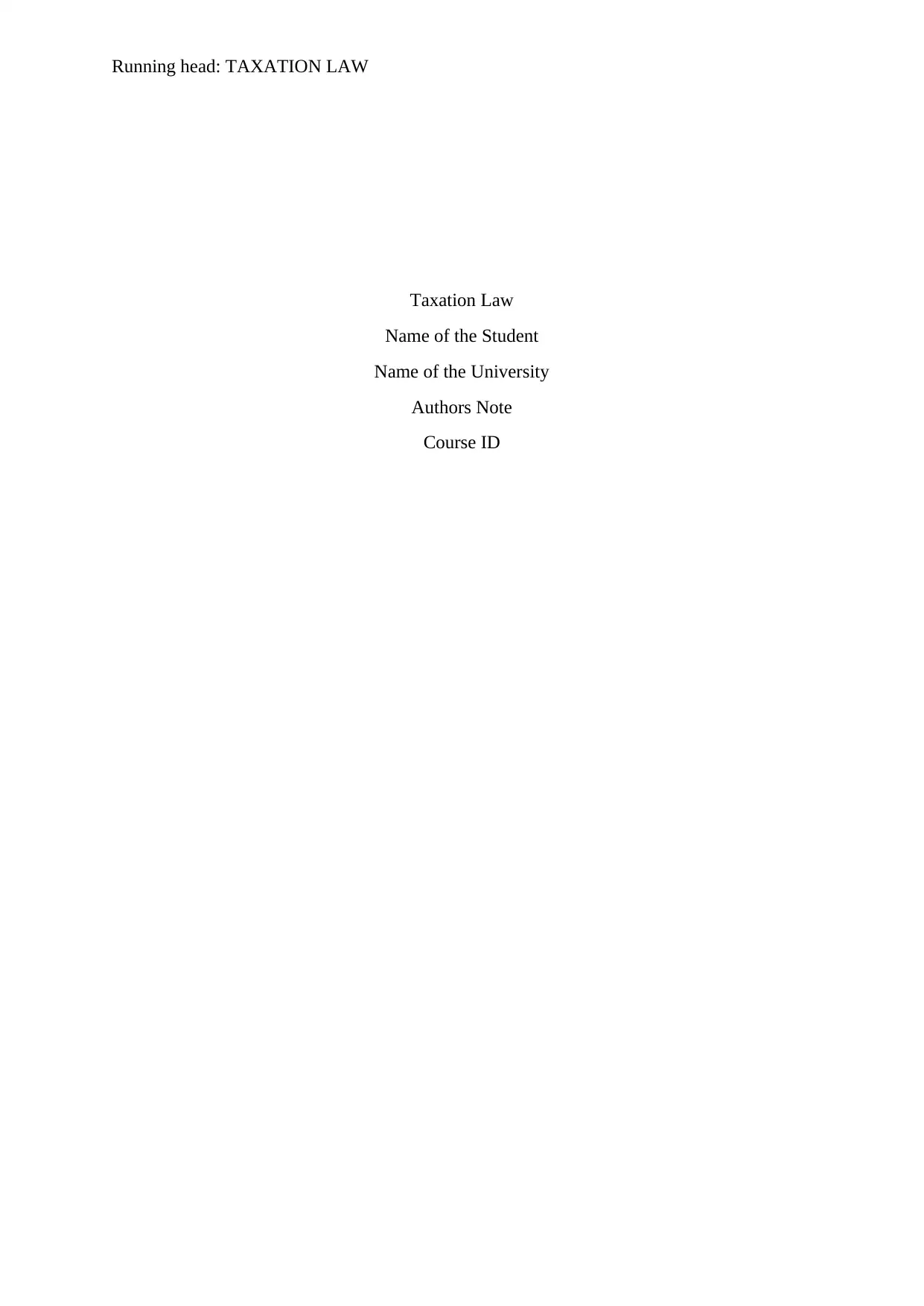
Running head: TAXATION LAW
Taxation Law
Name of the Student
Name of the University
Authors Note
Course ID
Taxation Law
Name of the Student
Name of the University
Authors Note
Course ID
Paraphrase This Document
Need a fresh take? Get an instant paraphrase of this document with our AI Paraphraser
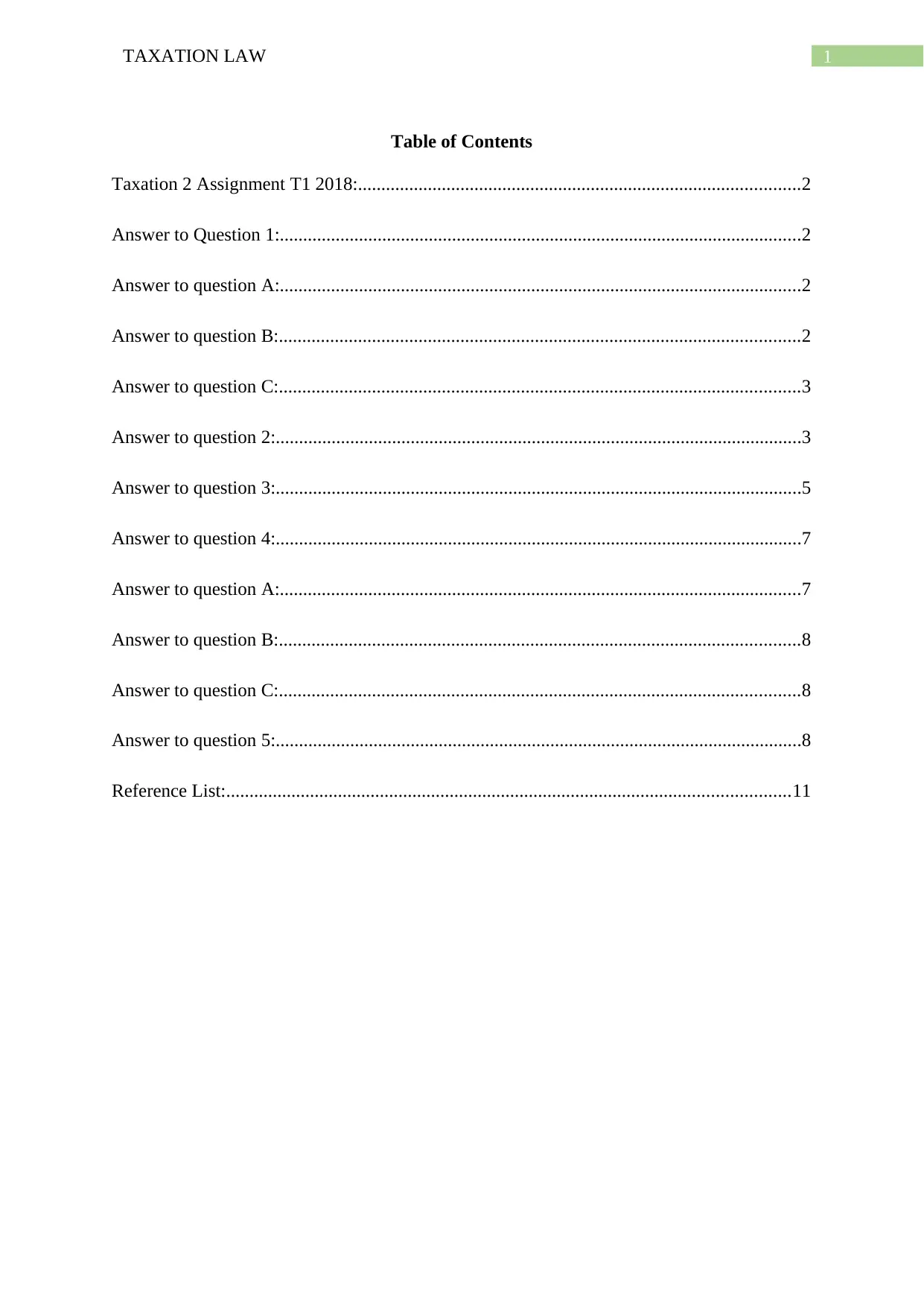
1TAXATION LAW
Table of Contents
Taxation 2 Assignment T1 2018:...............................................................................................2
Answer to Question 1:................................................................................................................2
Answer to question A:................................................................................................................2
Answer to question B:................................................................................................................2
Answer to question C:................................................................................................................3
Answer to question 2:.................................................................................................................3
Answer to question 3:.................................................................................................................5
Answer to question 4:.................................................................................................................7
Answer to question A:................................................................................................................7
Answer to question B:................................................................................................................8
Answer to question C:................................................................................................................8
Answer to question 5:.................................................................................................................8
Reference List:.........................................................................................................................11
Table of Contents
Taxation 2 Assignment T1 2018:...............................................................................................2
Answer to Question 1:................................................................................................................2
Answer to question A:................................................................................................................2
Answer to question B:................................................................................................................2
Answer to question C:................................................................................................................3
Answer to question 2:.................................................................................................................3
Answer to question 3:.................................................................................................................5
Answer to question 4:.................................................................................................................7
Answer to question A:................................................................................................................7
Answer to question B:................................................................................................................8
Answer to question C:................................................................................................................8
Answer to question 5:.................................................................................................................8
Reference List:.........................................................................................................................11
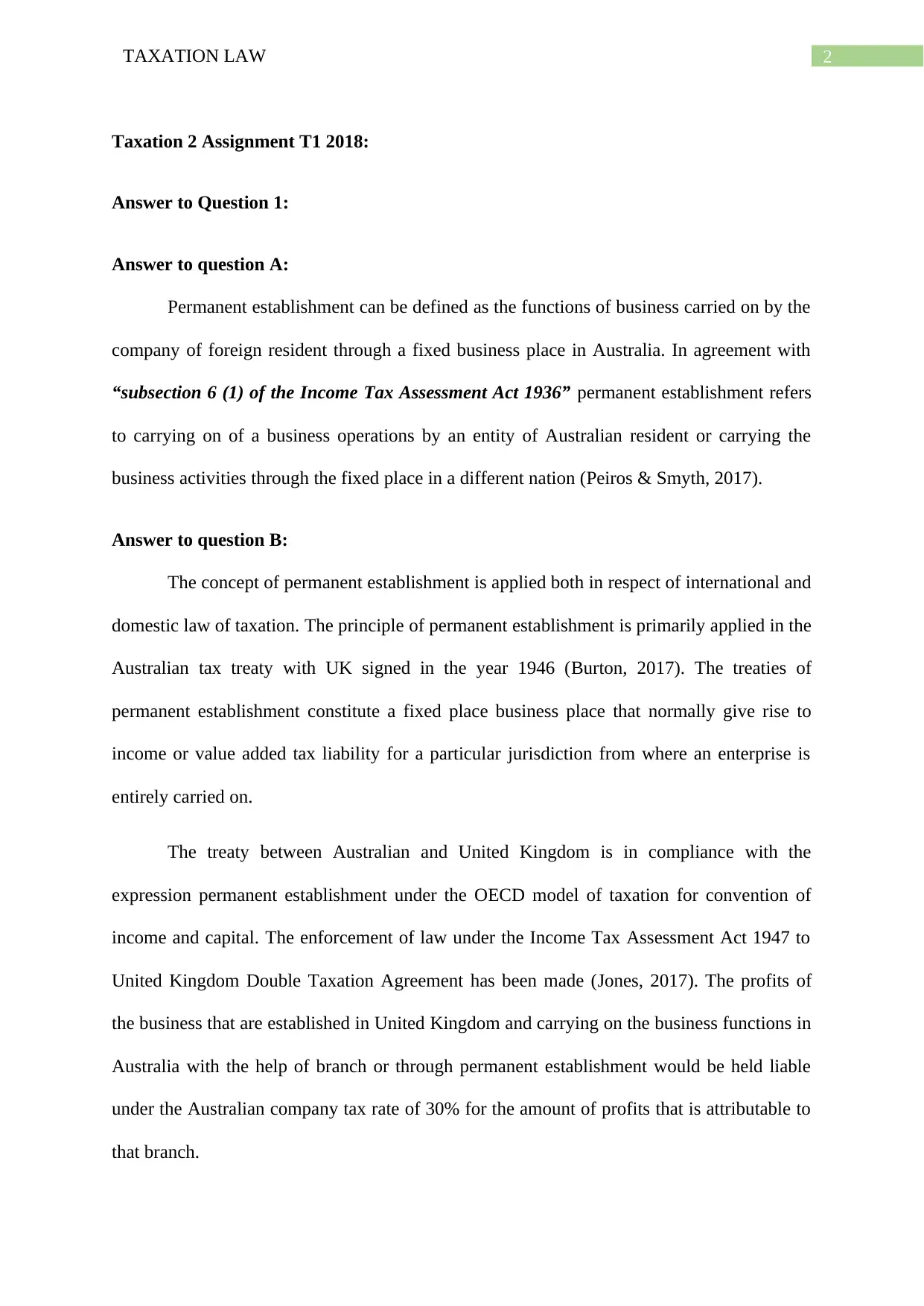
2TAXATION LAW
Taxation 2 Assignment T1 2018:
Answer to Question 1:
Answer to question A:
Permanent establishment can be defined as the functions of business carried on by the
company of foreign resident through a fixed business place in Australia. In agreement with
“subsection 6 (1) of the Income Tax Assessment Act 1936” permanent establishment refers
to carrying on of a business operations by an entity of Australian resident or carrying the
business activities through the fixed place in a different nation (Peiros & Smyth, 2017).
Answer to question B:
The concept of permanent establishment is applied both in respect of international and
domestic law of taxation. The principle of permanent establishment is primarily applied in the
Australian tax treaty with UK signed in the year 1946 (Burton, 2017). The treaties of
permanent establishment constitute a fixed place business place that normally give rise to
income or value added tax liability for a particular jurisdiction from where an enterprise is
entirely carried on.
The treaty between Australian and United Kingdom is in compliance with the
expression permanent establishment under the OECD model of taxation for convention of
income and capital. The enforcement of law under the Income Tax Assessment Act 1947 to
United Kingdom Double Taxation Agreement has been made (Jones, 2017). The profits of
the business that are established in United Kingdom and carrying on the business functions in
Australia with the help of branch or through permanent establishment would be held liable
under the Australian company tax rate of 30% for the amount of profits that is attributable to
that branch.
Taxation 2 Assignment T1 2018:
Answer to Question 1:
Answer to question A:
Permanent establishment can be defined as the functions of business carried on by the
company of foreign resident through a fixed business place in Australia. In agreement with
“subsection 6 (1) of the Income Tax Assessment Act 1936” permanent establishment refers
to carrying on of a business operations by an entity of Australian resident or carrying the
business activities through the fixed place in a different nation (Peiros & Smyth, 2017).
Answer to question B:
The concept of permanent establishment is applied both in respect of international and
domestic law of taxation. The principle of permanent establishment is primarily applied in the
Australian tax treaty with UK signed in the year 1946 (Burton, 2017). The treaties of
permanent establishment constitute a fixed place business place that normally give rise to
income or value added tax liability for a particular jurisdiction from where an enterprise is
entirely carried on.
The treaty between Australian and United Kingdom is in compliance with the
expression permanent establishment under the OECD model of taxation for convention of
income and capital. The enforcement of law under the Income Tax Assessment Act 1947 to
United Kingdom Double Taxation Agreement has been made (Jones, 2017). The profits of
the business that are established in United Kingdom and carrying on the business functions in
Australia with the help of branch or through permanent establishment would be held liable
under the Australian company tax rate of 30% for the amount of profits that is attributable to
that branch.
⊘ This is a preview!⊘
Do you want full access?
Subscribe today to unlock all pages.

Trusted by 1+ million students worldwide
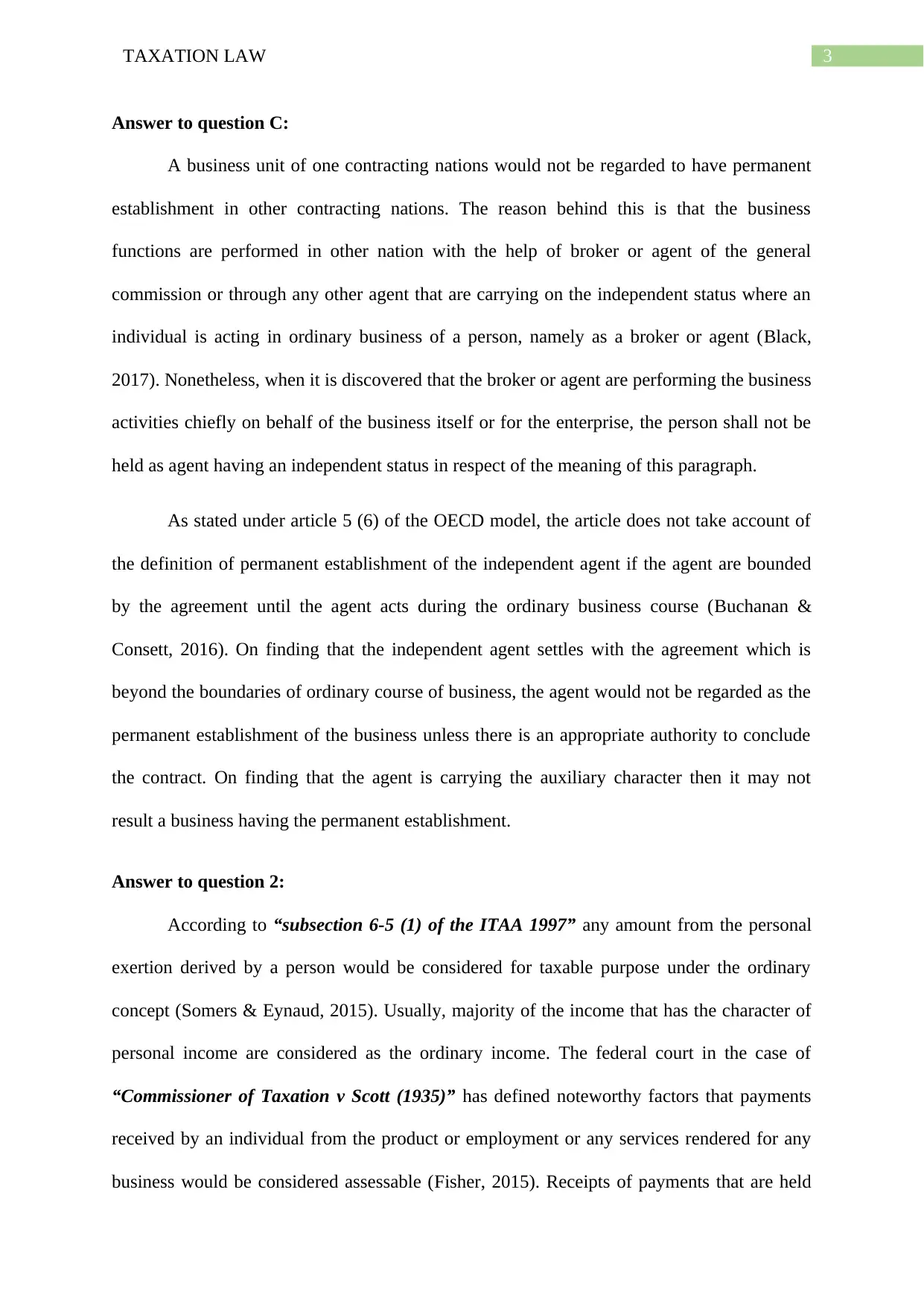
3TAXATION LAW
Answer to question C:
A business unit of one contracting nations would not be regarded to have permanent
establishment in other contracting nations. The reason behind this is that the business
functions are performed in other nation with the help of broker or agent of the general
commission or through any other agent that are carrying on the independent status where an
individual is acting in ordinary business of a person, namely as a broker or agent (Black,
2017). Nonetheless, when it is discovered that the broker or agent are performing the business
activities chiefly on behalf of the business itself or for the enterprise, the person shall not be
held as agent having an independent status in respect of the meaning of this paragraph.
As stated under article 5 (6) of the OECD model, the article does not take account of
the definition of permanent establishment of the independent agent if the agent are bounded
by the agreement until the agent acts during the ordinary business course (Buchanan &
Consett, 2016). On finding that the independent agent settles with the agreement which is
beyond the boundaries of ordinary course of business, the agent would not be regarded as the
permanent establishment of the business unless there is an appropriate authority to conclude
the contract. On finding that the agent is carrying the auxiliary character then it may not
result a business having the permanent establishment.
Answer to question 2:
According to “subsection 6-5 (1) of the ITAA 1997” any amount from the personal
exertion derived by a person would be considered for taxable purpose under the ordinary
concept (Somers & Eynaud, 2015). Usually, majority of the income that has the character of
personal income are considered as the ordinary income. The federal court in the case of
“Commissioner of Taxation v Scott (1935)” has defined noteworthy factors that payments
received by an individual from the product or employment or any services rendered for any
business would be considered assessable (Fisher, 2015). Receipts of payments that are held
Answer to question C:
A business unit of one contracting nations would not be regarded to have permanent
establishment in other contracting nations. The reason behind this is that the business
functions are performed in other nation with the help of broker or agent of the general
commission or through any other agent that are carrying on the independent status where an
individual is acting in ordinary business of a person, namely as a broker or agent (Black,
2017). Nonetheless, when it is discovered that the broker or agent are performing the business
activities chiefly on behalf of the business itself or for the enterprise, the person shall not be
held as agent having an independent status in respect of the meaning of this paragraph.
As stated under article 5 (6) of the OECD model, the article does not take account of
the definition of permanent establishment of the independent agent if the agent are bounded
by the agreement until the agent acts during the ordinary business course (Buchanan &
Consett, 2016). On finding that the independent agent settles with the agreement which is
beyond the boundaries of ordinary course of business, the agent would not be regarded as the
permanent establishment of the business unless there is an appropriate authority to conclude
the contract. On finding that the agent is carrying the auxiliary character then it may not
result a business having the permanent establishment.
Answer to question 2:
According to “subsection 6-5 (1) of the ITAA 1997” any amount from the personal
exertion derived by a person would be considered for taxable purpose under the ordinary
concept (Somers & Eynaud, 2015). Usually, majority of the income that has the character of
personal income are considered as the ordinary income. The federal court in the case of
“Commissioner of Taxation v Scott (1935)” has defined noteworthy factors that payments
received by an individual from the product or employment or any services rendered for any
business would be considered assessable (Fisher, 2015). Receipts of payments that are held
Paraphrase This Document
Need a fresh take? Get an instant paraphrase of this document with our AI Paraphraser
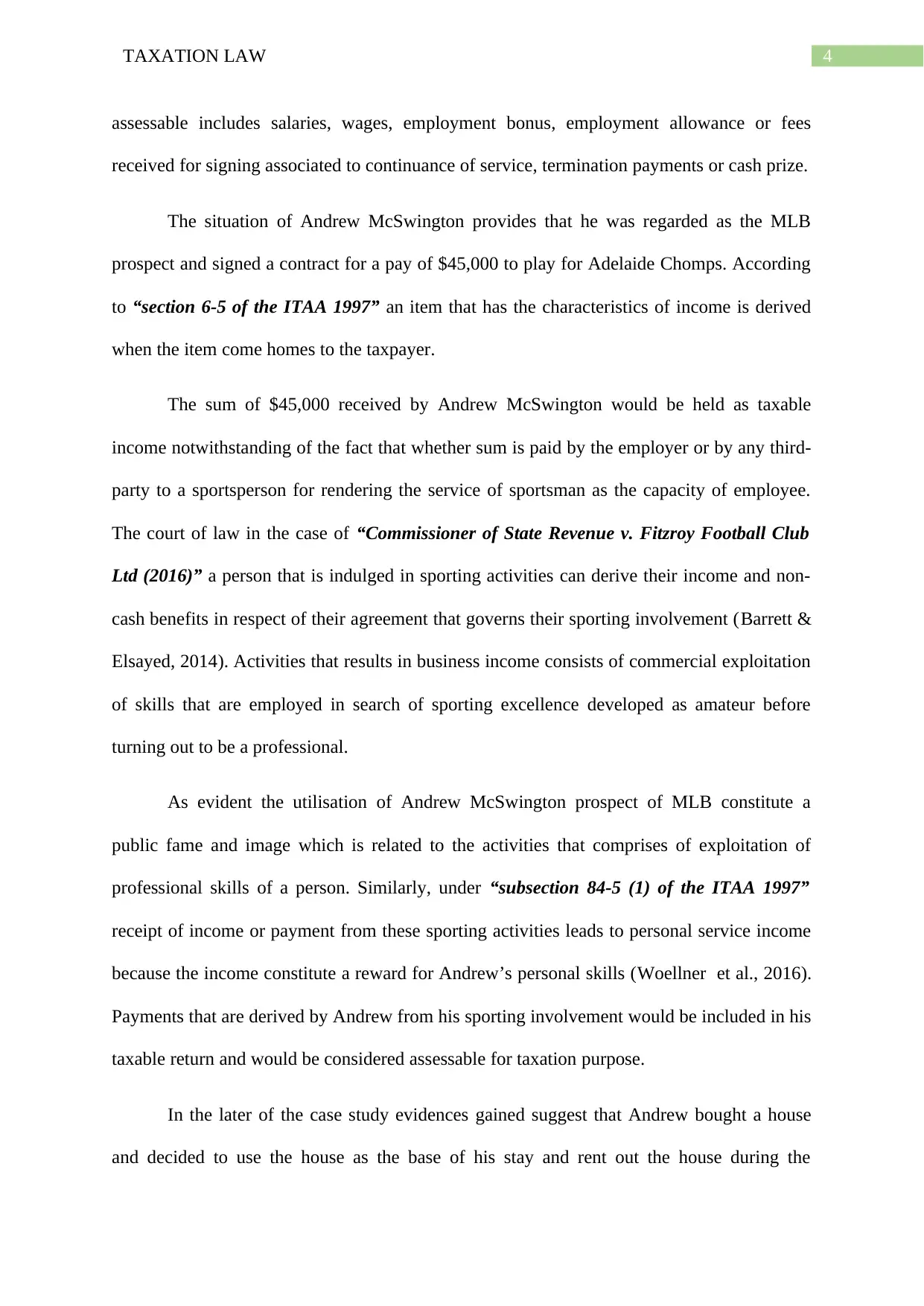
4TAXATION LAW
assessable includes salaries, wages, employment bonus, employment allowance or fees
received for signing associated to continuance of service, termination payments or cash prize.
The situation of Andrew McSwington provides that he was regarded as the MLB
prospect and signed a contract for a pay of $45,000 to play for Adelaide Chomps. According
to “section 6-5 of the ITAA 1997” an item that has the characteristics of income is derived
when the item come homes to the taxpayer.
The sum of $45,000 received by Andrew McSwington would be held as taxable
income notwithstanding of the fact that whether sum is paid by the employer or by any third-
party to a sportsperson for rendering the service of sportsman as the capacity of employee.
The court of law in the case of “Commissioner of State Revenue v. Fitzroy Football Club
Ltd (2016)” a person that is indulged in sporting activities can derive their income and non-
cash benefits in respect of their agreement that governs their sporting involvement (Barrett &
Elsayed, 2014). Activities that results in business income consists of commercial exploitation
of skills that are employed in search of sporting excellence developed as amateur before
turning out to be a professional.
As evident the utilisation of Andrew McSwington prospect of MLB constitute a
public fame and image which is related to the activities that comprises of exploitation of
professional skills of a person. Similarly, under “subsection 84-5 (1) of the ITAA 1997”
receipt of income or payment from these sporting activities leads to personal service income
because the income constitute a reward for Andrew’s personal skills (Woellner et al., 2016).
Payments that are derived by Andrew from his sporting involvement would be included in his
taxable return and would be considered assessable for taxation purpose.
In the later of the case study evidences gained suggest that Andrew bought a house
and decided to use the house as the base of his stay and rent out the house during the
assessable includes salaries, wages, employment bonus, employment allowance or fees
received for signing associated to continuance of service, termination payments or cash prize.
The situation of Andrew McSwington provides that he was regarded as the MLB
prospect and signed a contract for a pay of $45,000 to play for Adelaide Chomps. According
to “section 6-5 of the ITAA 1997” an item that has the characteristics of income is derived
when the item come homes to the taxpayer.
The sum of $45,000 received by Andrew McSwington would be held as taxable
income notwithstanding of the fact that whether sum is paid by the employer or by any third-
party to a sportsperson for rendering the service of sportsman as the capacity of employee.
The court of law in the case of “Commissioner of State Revenue v. Fitzroy Football Club
Ltd (2016)” a person that is indulged in sporting activities can derive their income and non-
cash benefits in respect of their agreement that governs their sporting involvement (Barrett &
Elsayed, 2014). Activities that results in business income consists of commercial exploitation
of skills that are employed in search of sporting excellence developed as amateur before
turning out to be a professional.
As evident the utilisation of Andrew McSwington prospect of MLB constitute a
public fame and image which is related to the activities that comprises of exploitation of
professional skills of a person. Similarly, under “subsection 84-5 (1) of the ITAA 1997”
receipt of income or payment from these sporting activities leads to personal service income
because the income constitute a reward for Andrew’s personal skills (Woellner et al., 2016).
Payments that are derived by Andrew from his sporting involvement would be included in his
taxable return and would be considered assessable for taxation purpose.
In the later of the case study evidences gained suggest that Andrew bought a house
and decided to use the house as the base of his stay and rent out the house during the
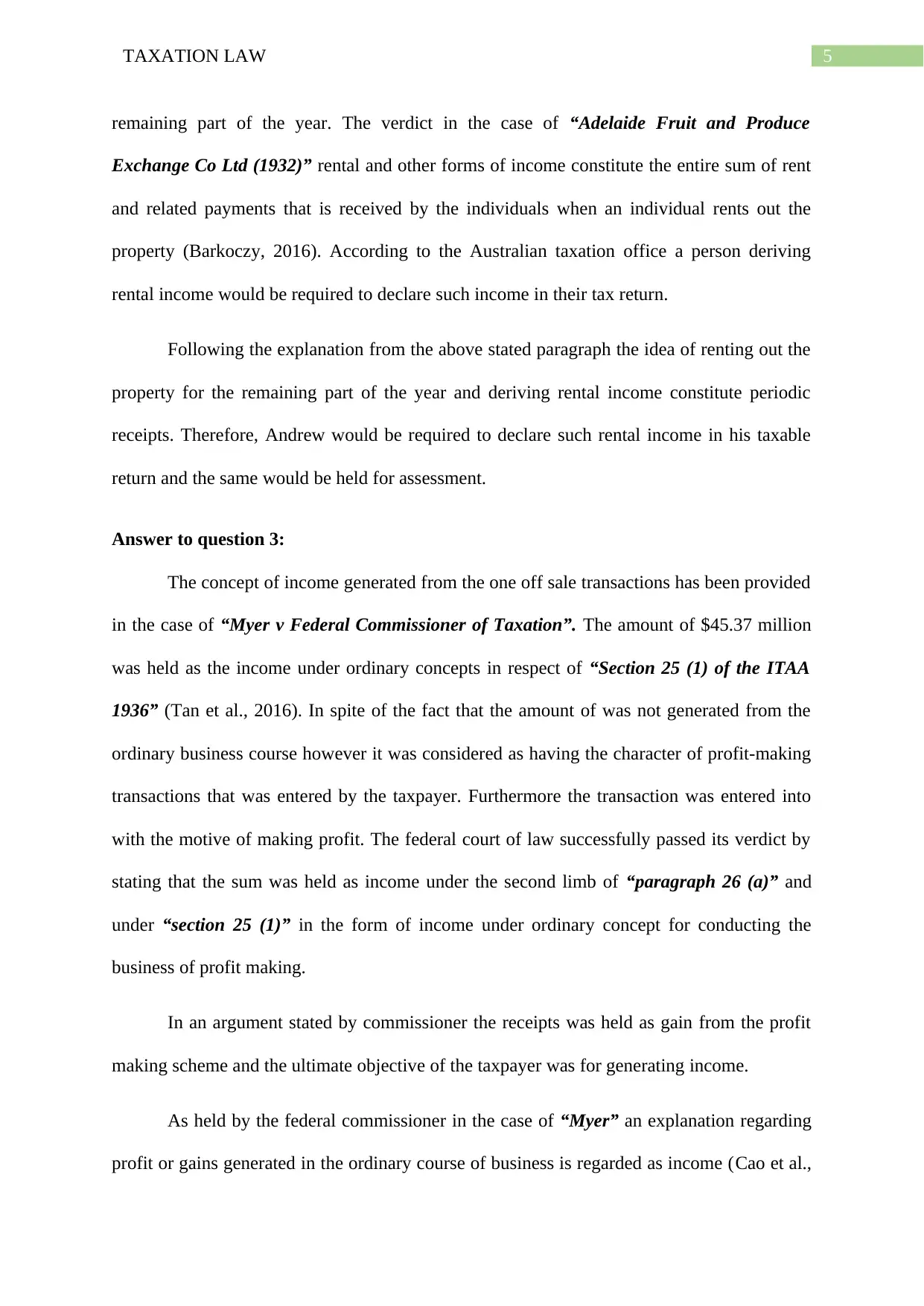
5TAXATION LAW
remaining part of the year. The verdict in the case of “Adelaide Fruit and Produce
Exchange Co Ltd (1932)” rental and other forms of income constitute the entire sum of rent
and related payments that is received by the individuals when an individual rents out the
property (Barkoczy, 2016). According to the Australian taxation office a person deriving
rental income would be required to declare such income in their tax return.
Following the explanation from the above stated paragraph the idea of renting out the
property for the remaining part of the year and deriving rental income constitute periodic
receipts. Therefore, Andrew would be required to declare such rental income in his taxable
return and the same would be held for assessment.
Answer to question 3:
The concept of income generated from the one off sale transactions has been provided
in the case of “Myer v Federal Commissioner of Taxation”. The amount of $45.37 million
was held as the income under ordinary concepts in respect of “Section 25 (1) of the ITAA
1936” (Tan et al., 2016). In spite of the fact that the amount of was not generated from the
ordinary business course however it was considered as having the character of profit-making
transactions that was entered by the taxpayer. Furthermore the transaction was entered into
with the motive of making profit. The federal court of law successfully passed its verdict by
stating that the sum was held as income under the second limb of “paragraph 26 (a)” and
under “section 25 (1)” in the form of income under ordinary concept for conducting the
business of profit making.
In an argument stated by commissioner the receipts was held as gain from the profit
making scheme and the ultimate objective of the taxpayer was for generating income.
As held by the federal commissioner in the case of “Myer” an explanation regarding
profit or gains generated in the ordinary course of business is regarded as income (Cao et al.,
remaining part of the year. The verdict in the case of “Adelaide Fruit and Produce
Exchange Co Ltd (1932)” rental and other forms of income constitute the entire sum of rent
and related payments that is received by the individuals when an individual rents out the
property (Barkoczy, 2016). According to the Australian taxation office a person deriving
rental income would be required to declare such income in their tax return.
Following the explanation from the above stated paragraph the idea of renting out the
property for the remaining part of the year and deriving rental income constitute periodic
receipts. Therefore, Andrew would be required to declare such rental income in his taxable
return and the same would be held for assessment.
Answer to question 3:
The concept of income generated from the one off sale transactions has been provided
in the case of “Myer v Federal Commissioner of Taxation”. The amount of $45.37 million
was held as the income under ordinary concepts in respect of “Section 25 (1) of the ITAA
1936” (Tan et al., 2016). In spite of the fact that the amount of was not generated from the
ordinary business course however it was considered as having the character of profit-making
transactions that was entered by the taxpayer. Furthermore the transaction was entered into
with the motive of making profit. The federal court of law successfully passed its verdict by
stating that the sum was held as income under the second limb of “paragraph 26 (a)” and
under “section 25 (1)” in the form of income under ordinary concept for conducting the
business of profit making.
In an argument stated by commissioner the receipts was held as gain from the profit
making scheme and the ultimate objective of the taxpayer was for generating income.
As held by the federal commissioner in the case of “Myer” an explanation regarding
profit or gains generated in the ordinary course of business is regarded as income (Cao et al.,
⊘ This is a preview!⊘
Do you want full access?
Subscribe today to unlock all pages.

Trusted by 1+ million students worldwide
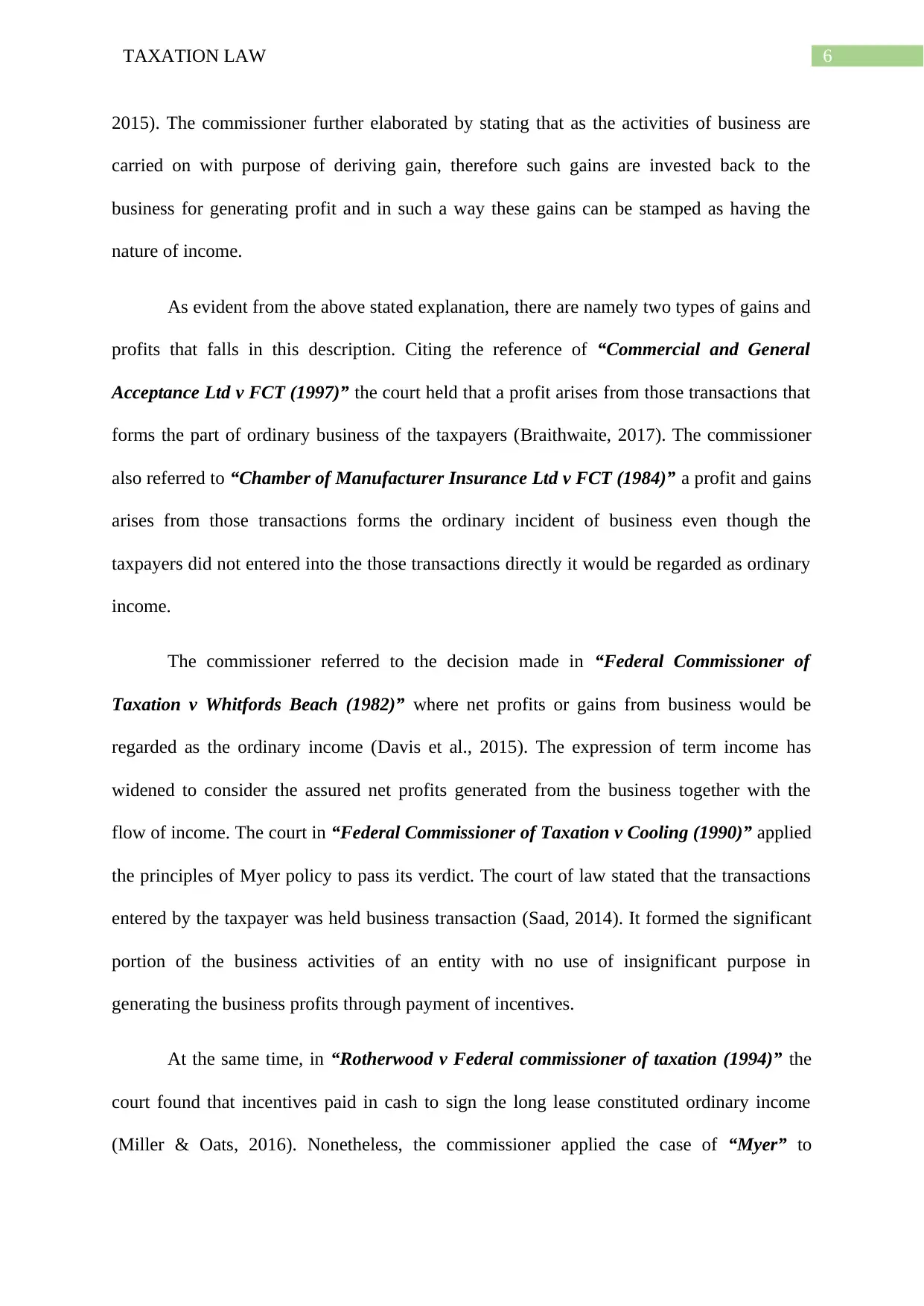
6TAXATION LAW
2015). The commissioner further elaborated by stating that as the activities of business are
carried on with purpose of deriving gain, therefore such gains are invested back to the
business for generating profit and in such a way these gains can be stamped as having the
nature of income.
As evident from the above stated explanation, there are namely two types of gains and
profits that falls in this description. Citing the reference of “Commercial and General
Acceptance Ltd v FCT (1997)” the court held that a profit arises from those transactions that
forms the part of ordinary business of the taxpayers (Braithwaite, 2017). The commissioner
also referred to “Chamber of Manufacturer Insurance Ltd v FCT (1984)” a profit and gains
arises from those transactions forms the ordinary incident of business even though the
taxpayers did not entered into the those transactions directly it would be regarded as ordinary
income.
The commissioner referred to the decision made in “Federal Commissioner of
Taxation v Whitfords Beach (1982)” where net profits or gains from business would be
regarded as the ordinary income (Davis et al., 2015). The expression of term income has
widened to consider the assured net profits generated from the business together with the
flow of income. The court in “Federal Commissioner of Taxation v Cooling (1990)” applied
the principles of Myer policy to pass its verdict. The court of law stated that the transactions
entered by the taxpayer was held business transaction (Saad, 2014). It formed the significant
portion of the business activities of an entity with no use of insignificant purpose in
generating the business profits through payment of incentives.
At the same time, in “Rotherwood v Federal commissioner of taxation (1994)” the
court found that incentives paid in cash to sign the long lease constituted ordinary income
(Miller & Oats, 2016). Nonetheless, the commissioner applied the case of “Myer” to
2015). The commissioner further elaborated by stating that as the activities of business are
carried on with purpose of deriving gain, therefore such gains are invested back to the
business for generating profit and in such a way these gains can be stamped as having the
nature of income.
As evident from the above stated explanation, there are namely two types of gains and
profits that falls in this description. Citing the reference of “Commercial and General
Acceptance Ltd v FCT (1997)” the court held that a profit arises from those transactions that
forms the part of ordinary business of the taxpayers (Braithwaite, 2017). The commissioner
also referred to “Chamber of Manufacturer Insurance Ltd v FCT (1984)” a profit and gains
arises from those transactions forms the ordinary incident of business even though the
taxpayers did not entered into the those transactions directly it would be regarded as ordinary
income.
The commissioner referred to the decision made in “Federal Commissioner of
Taxation v Whitfords Beach (1982)” where net profits or gains from business would be
regarded as the ordinary income (Davis et al., 2015). The expression of term income has
widened to consider the assured net profits generated from the business together with the
flow of income. The court in “Federal Commissioner of Taxation v Cooling (1990)” applied
the principles of Myer policy to pass its verdict. The court of law stated that the transactions
entered by the taxpayer was held business transaction (Saad, 2014). It formed the significant
portion of the business activities of an entity with no use of insignificant purpose in
generating the business profits through payment of incentives.
At the same time, in “Rotherwood v Federal commissioner of taxation (1994)” the
court found that incentives paid in cash to sign the long lease constituted ordinary income
(Miller & Oats, 2016). Nonetheless, the commissioner applied the case of “Myer” to
Paraphrase This Document
Need a fresh take? Get an instant paraphrase of this document with our AI Paraphraser
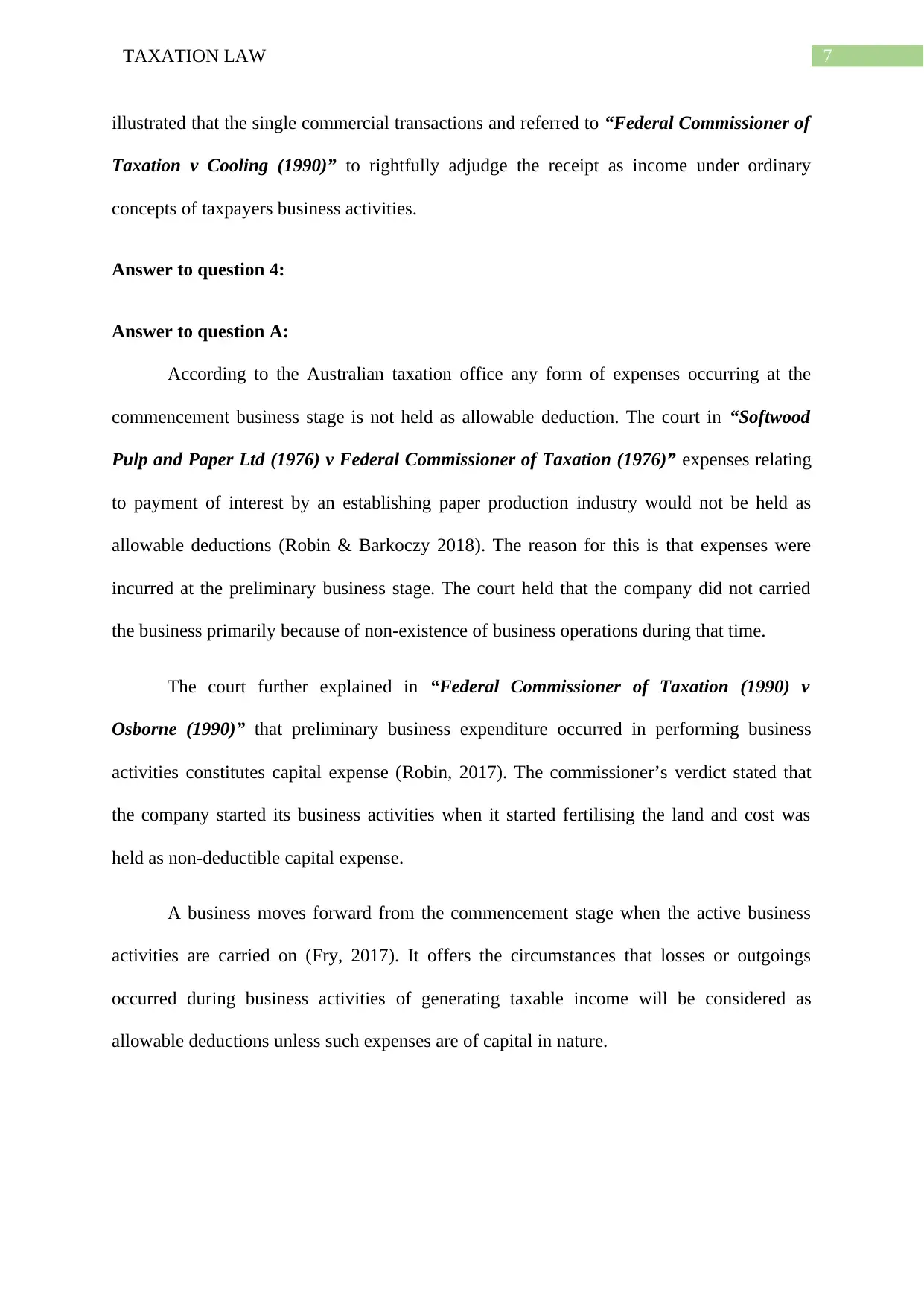
7TAXATION LAW
illustrated that the single commercial transactions and referred to “Federal Commissioner of
Taxation v Cooling (1990)” to rightfully adjudge the receipt as income under ordinary
concepts of taxpayers business activities.
Answer to question 4:
Answer to question A:
According to the Australian taxation office any form of expenses occurring at the
commencement business stage is not held as allowable deduction. The court in “Softwood
Pulp and Paper Ltd (1976) v Federal Commissioner of Taxation (1976)” expenses relating
to payment of interest by an establishing paper production industry would not be held as
allowable deductions (Robin & Barkoczy 2018). The reason for this is that expenses were
incurred at the preliminary business stage. The court held that the company did not carried
the business primarily because of non-existence of business operations during that time.
The court further explained in “Federal Commissioner of Taxation (1990) v
Osborne (1990)” that preliminary business expenditure occurred in performing business
activities constitutes capital expense (Robin, 2017). The commissioner’s verdict stated that
the company started its business activities when it started fertilising the land and cost was
held as non-deductible capital expense.
A business moves forward from the commencement stage when the active business
activities are carried on (Fry, 2017). It offers the circumstances that losses or outgoings
occurred during business activities of generating taxable income will be considered as
allowable deductions unless such expenses are of capital in nature.
illustrated that the single commercial transactions and referred to “Federal Commissioner of
Taxation v Cooling (1990)” to rightfully adjudge the receipt as income under ordinary
concepts of taxpayers business activities.
Answer to question 4:
Answer to question A:
According to the Australian taxation office any form of expenses occurring at the
commencement business stage is not held as allowable deduction. The court in “Softwood
Pulp and Paper Ltd (1976) v Federal Commissioner of Taxation (1976)” expenses relating
to payment of interest by an establishing paper production industry would not be held as
allowable deductions (Robin & Barkoczy 2018). The reason for this is that expenses were
incurred at the preliminary business stage. The court held that the company did not carried
the business primarily because of non-existence of business operations during that time.
The court further explained in “Federal Commissioner of Taxation (1990) v
Osborne (1990)” that preliminary business expenditure occurred in performing business
activities constitutes capital expense (Robin, 2017). The commissioner’s verdict stated that
the company started its business activities when it started fertilising the land and cost was
held as non-deductible capital expense.
A business moves forward from the commencement stage when the active business
activities are carried on (Fry, 2017). It offers the circumstances that losses or outgoings
occurred during business activities of generating taxable income will be considered as
allowable deductions unless such expenses are of capital in nature.
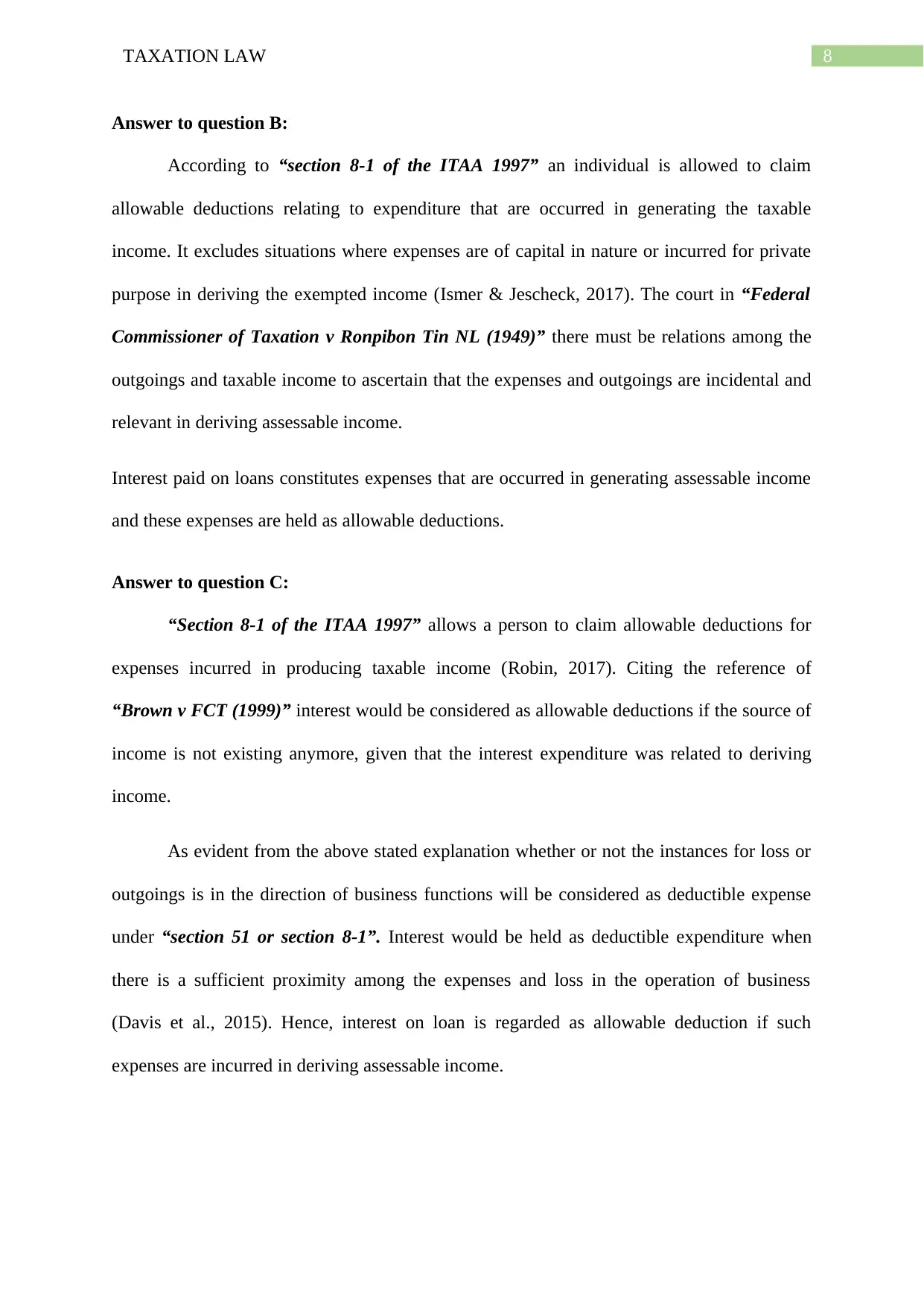
8TAXATION LAW
Answer to question B:
According to “section 8-1 of the ITAA 1997” an individual is allowed to claim
allowable deductions relating to expenditure that are occurred in generating the taxable
income. It excludes situations where expenses are of capital in nature or incurred for private
purpose in deriving the exempted income (Ismer & Jescheck, 2017). The court in “Federal
Commissioner of Taxation v Ronpibon Tin NL (1949)” there must be relations among the
outgoings and taxable income to ascertain that the expenses and outgoings are incidental and
relevant in deriving assessable income.
Interest paid on loans constitutes expenses that are occurred in generating assessable income
and these expenses are held as allowable deductions.
Answer to question C:
“Section 8-1 of the ITAA 1997” allows a person to claim allowable deductions for
expenses incurred in producing taxable income (Robin, 2017). Citing the reference of
“Brown v FCT (1999)” interest would be considered as allowable deductions if the source of
income is not existing anymore, given that the interest expenditure was related to deriving
income.
As evident from the above stated explanation whether or not the instances for loss or
outgoings is in the direction of business functions will be considered as deductible expense
under “section 51 or section 8-1”. Interest would be held as deductible expenditure when
there is a sufficient proximity among the expenses and loss in the operation of business
(Davis et al., 2015). Hence, interest on loan is regarded as allowable deduction if such
expenses are incurred in deriving assessable income.
Answer to question B:
According to “section 8-1 of the ITAA 1997” an individual is allowed to claim
allowable deductions relating to expenditure that are occurred in generating the taxable
income. It excludes situations where expenses are of capital in nature or incurred for private
purpose in deriving the exempted income (Ismer & Jescheck, 2017). The court in “Federal
Commissioner of Taxation v Ronpibon Tin NL (1949)” there must be relations among the
outgoings and taxable income to ascertain that the expenses and outgoings are incidental and
relevant in deriving assessable income.
Interest paid on loans constitutes expenses that are occurred in generating assessable income
and these expenses are held as allowable deductions.
Answer to question C:
“Section 8-1 of the ITAA 1997” allows a person to claim allowable deductions for
expenses incurred in producing taxable income (Robin, 2017). Citing the reference of
“Brown v FCT (1999)” interest would be considered as allowable deductions if the source of
income is not existing anymore, given that the interest expenditure was related to deriving
income.
As evident from the above stated explanation whether or not the instances for loss or
outgoings is in the direction of business functions will be considered as deductible expense
under “section 51 or section 8-1”. Interest would be held as deductible expenditure when
there is a sufficient proximity among the expenses and loss in the operation of business
(Davis et al., 2015). Hence, interest on loan is regarded as allowable deduction if such
expenses are incurred in deriving assessable income.
⊘ This is a preview!⊘
Do you want full access?
Subscribe today to unlock all pages.

Trusted by 1+ million students worldwide
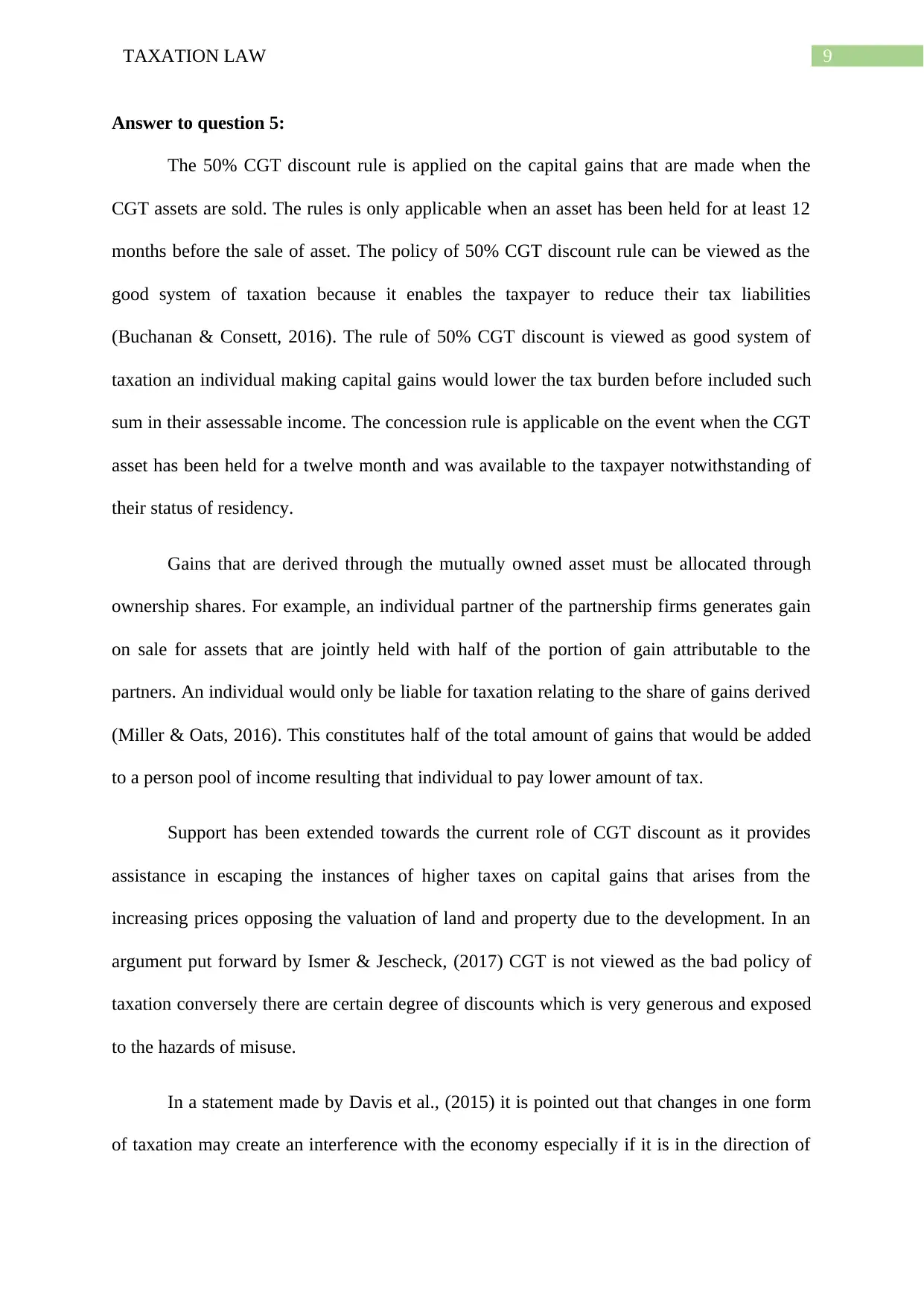
9TAXATION LAW
Answer to question 5:
The 50% CGT discount rule is applied on the capital gains that are made when the
CGT assets are sold. The rules is only applicable when an asset has been held for at least 12
months before the sale of asset. The policy of 50% CGT discount rule can be viewed as the
good system of taxation because it enables the taxpayer to reduce their tax liabilities
(Buchanan & Consett, 2016). The rule of 50% CGT discount is viewed as good system of
taxation an individual making capital gains would lower the tax burden before included such
sum in their assessable income. The concession rule is applicable on the event when the CGT
asset has been held for a twelve month and was available to the taxpayer notwithstanding of
their status of residency.
Gains that are derived through the mutually owned asset must be allocated through
ownership shares. For example, an individual partner of the partnership firms generates gain
on sale for assets that are jointly held with half of the portion of gain attributable to the
partners. An individual would only be liable for taxation relating to the share of gains derived
(Miller & Oats, 2016). This constitutes half of the total amount of gains that would be added
to a person pool of income resulting that individual to pay lower amount of tax.
Support has been extended towards the current role of CGT discount as it provides
assistance in escaping the instances of higher taxes on capital gains that arises from the
increasing prices opposing the valuation of land and property due to the development. In an
argument put forward by Ismer & Jescheck, (2017) CGT is not viewed as the bad policy of
taxation conversely there are certain degree of discounts which is very generous and exposed
to the hazards of misuse.
In a statement made by Davis et al., (2015) it is pointed out that changes in one form
of taxation may create an interference with the economy especially if it is in the direction of
Answer to question 5:
The 50% CGT discount rule is applied on the capital gains that are made when the
CGT assets are sold. The rules is only applicable when an asset has been held for at least 12
months before the sale of asset. The policy of 50% CGT discount rule can be viewed as the
good system of taxation because it enables the taxpayer to reduce their tax liabilities
(Buchanan & Consett, 2016). The rule of 50% CGT discount is viewed as good system of
taxation an individual making capital gains would lower the tax burden before included such
sum in their assessable income. The concession rule is applicable on the event when the CGT
asset has been held for a twelve month and was available to the taxpayer notwithstanding of
their status of residency.
Gains that are derived through the mutually owned asset must be allocated through
ownership shares. For example, an individual partner of the partnership firms generates gain
on sale for assets that are jointly held with half of the portion of gain attributable to the
partners. An individual would only be liable for taxation relating to the share of gains derived
(Miller & Oats, 2016). This constitutes half of the total amount of gains that would be added
to a person pool of income resulting that individual to pay lower amount of tax.
Support has been extended towards the current role of CGT discount as it provides
assistance in escaping the instances of higher taxes on capital gains that arises from the
increasing prices opposing the valuation of land and property due to the development. In an
argument put forward by Ismer & Jescheck, (2017) CGT is not viewed as the bad policy of
taxation conversely there are certain degree of discounts which is very generous and exposed
to the hazards of misuse.
In a statement made by Davis et al., (2015) it is pointed out that changes in one form
of taxation may create an interference with the economy especially if it is in the direction of
Paraphrase This Document
Need a fresh take? Get an instant paraphrase of this document with our AI Paraphraser
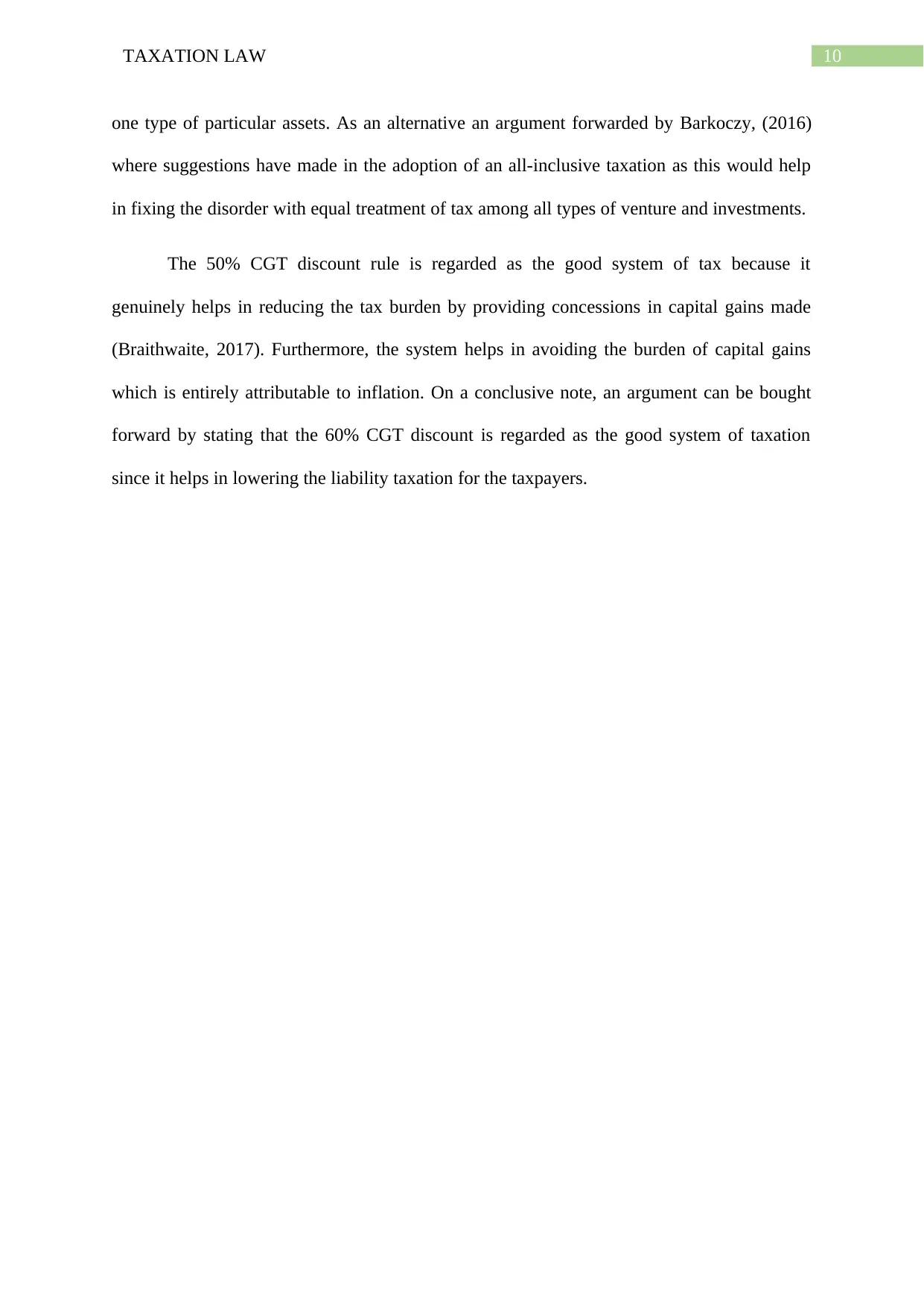
10TAXATION LAW
one type of particular assets. As an alternative an argument forwarded by Barkoczy, (2016)
where suggestions have made in the adoption of an all-inclusive taxation as this would help
in fixing the disorder with equal treatment of tax among all types of venture and investments.
The 50% CGT discount rule is regarded as the good system of tax because it
genuinely helps in reducing the tax burden by providing concessions in capital gains made
(Braithwaite, 2017). Furthermore, the system helps in avoiding the burden of capital gains
which is entirely attributable to inflation. On a conclusive note, an argument can be bought
forward by stating that the 60% CGT discount is regarded as the good system of taxation
since it helps in lowering the liability taxation for the taxpayers.
one type of particular assets. As an alternative an argument forwarded by Barkoczy, (2016)
where suggestions have made in the adoption of an all-inclusive taxation as this would help
in fixing the disorder with equal treatment of tax among all types of venture and investments.
The 50% CGT discount rule is regarded as the good system of tax because it
genuinely helps in reducing the tax burden by providing concessions in capital gains made
(Braithwaite, 2017). Furthermore, the system helps in avoiding the burden of capital gains
which is entirely attributable to inflation. On a conclusive note, an argument can be bought
forward by stating that the 60% CGT discount is regarded as the good system of taxation
since it helps in lowering the liability taxation for the taxpayers.
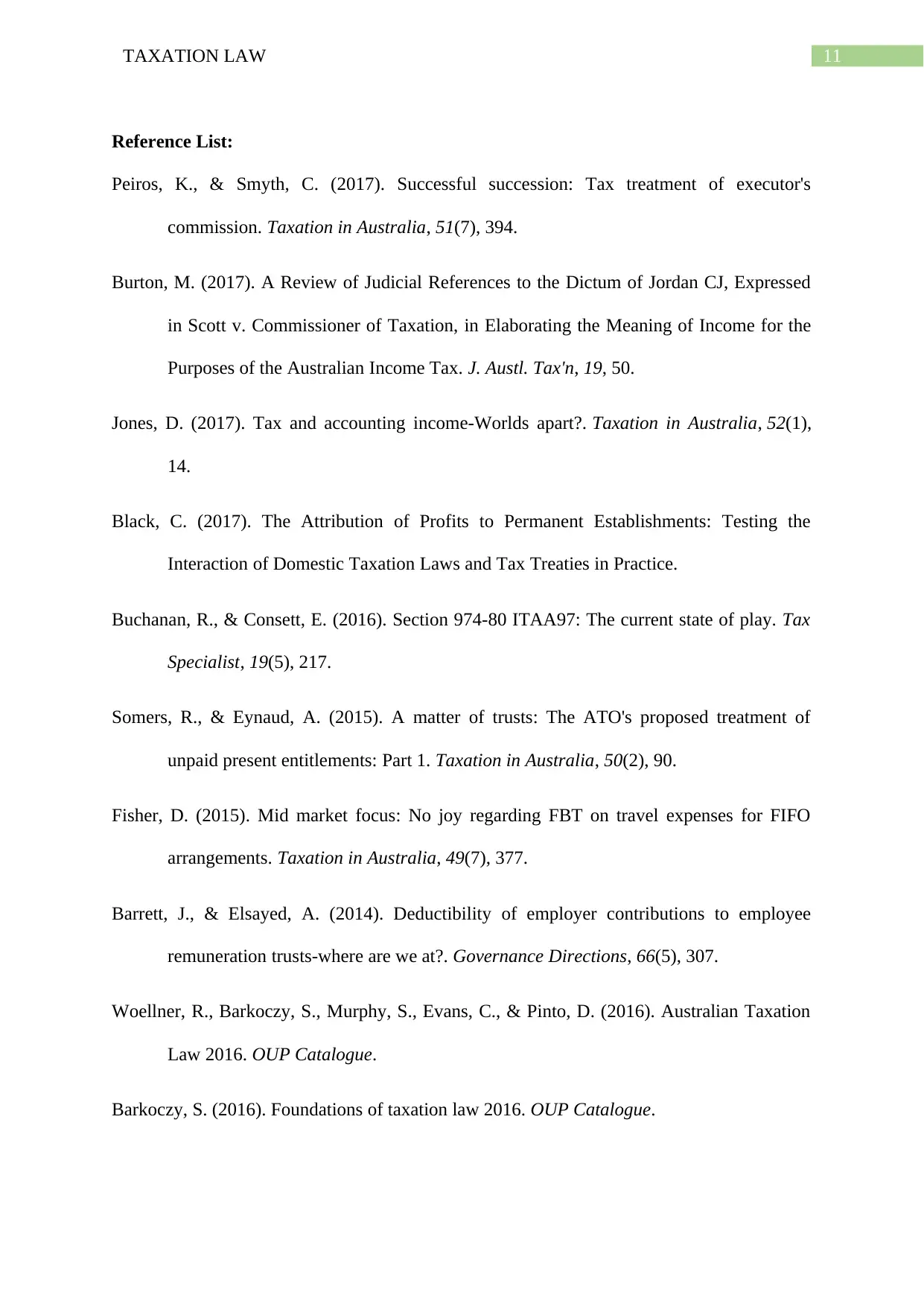
11TAXATION LAW
Reference List:
Peiros, K., & Smyth, C. (2017). Successful succession: Tax treatment of executor's
commission. Taxation in Australia, 51(7), 394.
Burton, M. (2017). A Review of Judicial References to the Dictum of Jordan CJ, Expressed
in Scott v. Commissioner of Taxation, in Elaborating the Meaning of Income for the
Purposes of the Australian Income Tax. J. Austl. Tax'n, 19, 50.
Jones, D. (2017). Tax and accounting income-Worlds apart?. Taxation in Australia, 52(1),
14.
Black, C. (2017). The Attribution of Profits to Permanent Establishments: Testing the
Interaction of Domestic Taxation Laws and Tax Treaties in Practice.
Buchanan, R., & Consett, E. (2016). Section 974-80 ITAA97: The current state of play. Tax
Specialist, 19(5), 217.
Somers, R., & Eynaud, A. (2015). A matter of trusts: The ATO's proposed treatment of
unpaid present entitlements: Part 1. Taxation in Australia, 50(2), 90.
Fisher, D. (2015). Mid market focus: No joy regarding FBT on travel expenses for FIFO
arrangements. Taxation in Australia, 49(7), 377.
Barrett, J., & Elsayed, A. (2014). Deductibility of employer contributions to employee
remuneration trusts-where are we at?. Governance Directions, 66(5), 307.
Woellner, R., Barkoczy, S., Murphy, S., Evans, C., & Pinto, D. (2016). Australian Taxation
Law 2016. OUP Catalogue.
Barkoczy, S. (2016). Foundations of taxation law 2016. OUP Catalogue.
Reference List:
Peiros, K., & Smyth, C. (2017). Successful succession: Tax treatment of executor's
commission. Taxation in Australia, 51(7), 394.
Burton, M. (2017). A Review of Judicial References to the Dictum of Jordan CJ, Expressed
in Scott v. Commissioner of Taxation, in Elaborating the Meaning of Income for the
Purposes of the Australian Income Tax. J. Austl. Tax'n, 19, 50.
Jones, D. (2017). Tax and accounting income-Worlds apart?. Taxation in Australia, 52(1),
14.
Black, C. (2017). The Attribution of Profits to Permanent Establishments: Testing the
Interaction of Domestic Taxation Laws and Tax Treaties in Practice.
Buchanan, R., & Consett, E. (2016). Section 974-80 ITAA97: The current state of play. Tax
Specialist, 19(5), 217.
Somers, R., & Eynaud, A. (2015). A matter of trusts: The ATO's proposed treatment of
unpaid present entitlements: Part 1. Taxation in Australia, 50(2), 90.
Fisher, D. (2015). Mid market focus: No joy regarding FBT on travel expenses for FIFO
arrangements. Taxation in Australia, 49(7), 377.
Barrett, J., & Elsayed, A. (2014). Deductibility of employer contributions to employee
remuneration trusts-where are we at?. Governance Directions, 66(5), 307.
Woellner, R., Barkoczy, S., Murphy, S., Evans, C., & Pinto, D. (2016). Australian Taxation
Law 2016. OUP Catalogue.
Barkoczy, S. (2016). Foundations of taxation law 2016. OUP Catalogue.
⊘ This is a preview!⊘
Do you want full access?
Subscribe today to unlock all pages.

Trusted by 1+ million students worldwide
1 out of 14
Related Documents
Your All-in-One AI-Powered Toolkit for Academic Success.
+13062052269
info@desklib.com
Available 24*7 on WhatsApp / Email
![[object Object]](/_next/static/media/star-bottom.7253800d.svg)
Unlock your academic potential
Copyright © 2020–2025 A2Z Services. All Rights Reserved. Developed and managed by ZUCOL.



